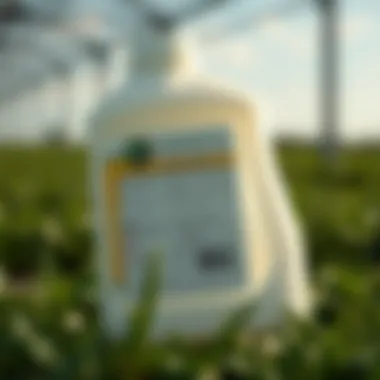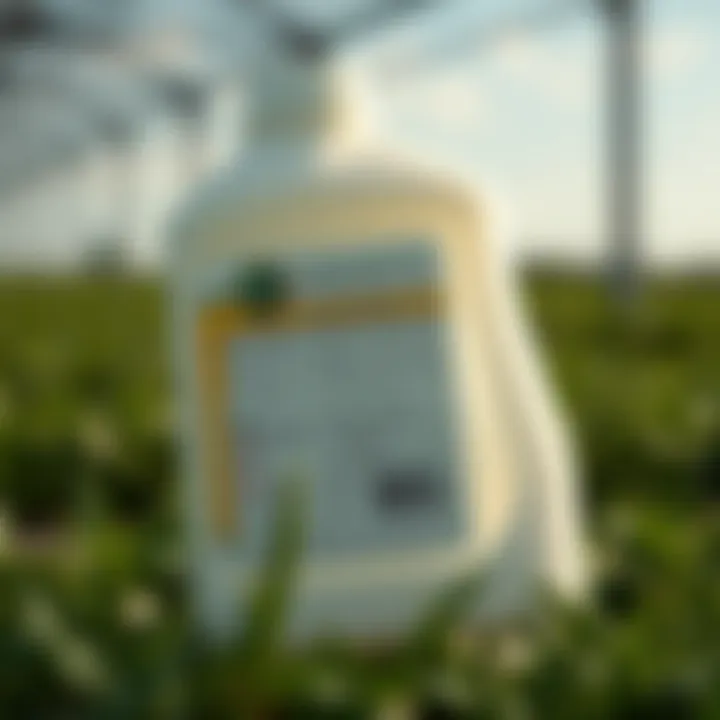Understanding Bayer's 3-in-1 Label: A Detailed Overview


Intro
In the ever-evolving landscape of agriculture, understanding how to optimize crop production while maintaining ecological balance is paramount. One product that stands out in this domain is Bayer’s 3-in-1 label, renowned for its multifaceted approach to pest management. This comprehensive guide will not only explore the features and applications of this innovative product but will also contextualize its significance within the framework of sustainable agricultural practices. With farming continuously reshaping in response to environmental concerns and technological advances, grasping the implications of Bayer's offerings is essential for those in the agricultural sector.
Let's plunge into the latest trends in agriculture to see how products like Bayer’s 3-in-1 fit into this broader picture.
Foreword to Bayer and Its Product Line
Understanding Bayer’s product line is essential to grasp the innovations that shape modern agriculture. Bayer Crop Science stands as a leader, intertwining science and practical solutions. This section outlines the significance of Bayer’s offerings and sets the stage for a discussion on their flagship solution – the 3-in-1 label, which incorporates multiple pest management strategies into one product.
Overview of Bayer Crop Science
Bayer Crop Science has made its mark by focusing on developing a wide range of products designed to improve crop yields while minimizing environmental impact. Their portfolio includes herbicides, insecticides, fungicides, and seed treatments. Each product is infused with scientific research and empirical data, ensuring farmers have access to reliable resources.
The company’s commitment to sustainability is evident in its approach to crop science. For example, Bayer emphasizes integrated pest management (IPM) practices, which not only ensure effective pest control but also enhance the long-term viability of agricultural ecosystems. Through these practices, Bayer aims to reduce reliance on single pest control methods, promoting a more holistic, environmentally friendly approach.
Importance of Integrated Solutions in Agriculture
In a rapidly evolving agricultural landscape, farmers face the dual challenge of increasing crop production and managing resources efficiently. Integrated solutions are essential to navigating these complexities. Here are a few key aspects:
- Efficiency: Integrated pest management combines biological, cultural, and chemical strategies, which leads to more efficient use of inputs. This multifaceted approach can reduce reliance on excessive pesticide applications.
- Sustainability: The long-term health of agricultural landscapes hinges on sustainable practices. By implementing Bayer’s integrated solutions, farmers can protect biodiversity while maintaining their crop yields.
- Resilience: Integrated strategies enhance resilience against pest outbreaks. When diverse strategies are employed, the ecosystem can better withstand and recover from pest invasions.
As we continue to explore Bayer’s 3-in-1 label, acknowledging these integrated solutions highlights the necessity of innovation in agriculture. It shows how new methods come together to offer comprehensive solutions that support not just farmers but also the environment.
Integrating multiple solutions in agriculture is not just an option; it's becoming a necessity to face the challenges of modern farming.
This underscores why Bayer's 3-in-1 product is such a pivotal offering—it's a response to these challenges, aiming to streamline pest management while bolstering sustainability.
The Concept of 3-in-1 Products
In the realm of modern agriculture, efficiency often stands as the guiding light for successful farming practices. One way to achieve this is through Bayer's innovative approach to product utilization—specifically, the 3-in-1 product concept. This reflects a significant movement towards simplifying pest control and maximizing agricultural output with fewer applications, while still addressing multiple issues concurrently. Understanding the 3-in-1 labels sheds light on their role in contemporary farming strategies.
Definition and Composition of 3-in-1 Labels
At its core, a 3-in-1 product integrates three critical functions into a single formula, seamlessly blending herbicides, insecticides, and fungicides into one application. This not only simplifies the treatment process but also addresses a broader spectrum of challenges faced by farmers. For instance, Bayer's 3-in-1 product may contain active ingredients specifically selected to tackle weed growth, combat insect infestations, and prevent fungal infections—all in one go.
The composition of these products is meticulously designed, ensuring that the balance of each component allows for effective interaction without compromising safety or efficacy. The goal is to create a synergistic effect that enhances their capabilities rather than hinders them.
Advantages of Multi-functionality in Agrochemicals
The benefits of utilizing multi-functional products in agriculture are manifold. Here are some notable advantages:
- Time Efficiency: Farmers no longer have to juggle multiple products for separate applications. With a 3-in-1 solution, they can save valuable time and resources.
- Cost-Effectiveness: Purchasing one product that accomplishes several tasks often proves cheaper than buying three separate items. This fosters better profit margins for farmers.
- Easier Management: Simplified application reduces the likelihood of application errors. Given that farmers can use fewer products, tracking usage and managing schedules becomes less complicated.
- Environmental Benefits: Fewer applications mean reduced exposure to chemicals in the environment. Greater precision in application also leads to lesser runoff, promoting a healthier ecosystem.
"Efficiency meets sustainability in Bayer’s 3-in-1 product approach. It reflects a deep understanding of the complexities within modern agriculture, where every drop counts."
By embedding multiple functionalities into a single product, Bayer positions itself at the forefront of innovative agricultural solutions, prioritizing not just efficiency but also the long-term health of our ecosystems.
Examining the Bayer 3-in-1 Label
Understanding the Bayer 3-in-1 label is crucial for any stakeholder in agriculture. It provides insight into how these products function to minimize pest and weed challenges while enhancing crop health. The 3-in-1 label indicates a unique product design that aims to simplify pest management for farmers, allowing them to deal with multiple issues using a single application. This is of particular benefit to those working with limited resources or in regions where time and efficiency are crucial for successful crop yields.
Core Components of the Bayer 3-in-1 Product
The Bayer 3-in-1 product comprises three essential components that synergize to tackle weeds, pests, and diseases. These ingredients typically include a herbicide, an insecticide, and a fungicide, each playing a specific role:
- Herbicide: This component targets unwanted plants that compete with crops for nutrients, water, and sunlight. It effectively ensures that crops are in an optimal growing environment.
- Insecticide: Designed to eliminate harmful insects that can damage crops, this product prevents potential yield losses due to pest activity.
- Fungicide: This element addresses fungal diseases that could compromise plant health, protecting the crops from infections that could hinder growth.
Together, these components form a comprehensive approach to agricultural pest management, aiming to streamline the process while providing effective solutions. A farmer can readily apply this single product, which achieves results that might otherwise require multiple applications of separate products.
Target Pests and Weeds Addressed
The Bayer 3-in-1 label targets a variety of pests and weeds. Some of the most commonly addressed include:
- Weeds: Some persistent weeds like Johnson grass, dandelion, and various broadleaf weeds that can choke crop productivity. The inclusion of a robust herbicide helps mitigate their impact.
- Insects: Common insects such as aphids, leafhoppers, and caterpillars, which often pose a significant threat to crops, can be managed more efficiently with the insecticide component.
- Fungal Pathogens: Pathogens like powdery mildew and downy mildew, which can devastate crops if left unchecked, are targeted with the fungicide.
Using Bayer's 3-in-1 label not only addresses three significant threats but also fosters an environment where crops can thrive without the added stress of competing organisms. Farmers can feel more confident in their choice, knowing they are using evidence-based products backed by extensive research and development.
"The Bayer 3-in-1 label offers a practical solution for modern farming challenges while helping to uphold sustainable practices."
Application and Usage Guidelines
Understanding the application and usage guidelines of Bayer's 3-in-1 label is not just essential for effective pest control; it's also a critical component for guiding farmers and agricultural enthusiasts in optimizing crop health. The right application can significantly influence the effectiveness of the product, ensuring compliance with agricultural best practices, and ultimately leading to enhanced yield potential. By adhering to the detailed application procedures and observing the optimal timing for treatment, users can avoid potential pitfalls that stem from improper use, such as crop damage or diminished product efficacy.


Detailed Application Procedures
When using Bayer’s 3-in-1 products, following the application procedures meticulously is key. Each product typically comes with a specific set of instructions tailored to its unique formulation and intended use.
- Preparation
Before diving into application, the farmer should gather all necessary equipment – this includes sprayers, protective gear, and the Bayer product itself. It’s advisable to ensure that the equipment is clean and functioning properly to prevent contamination or uneven distribution. - Mixing Techniques
It's critical to follow the mixing guidelines outlined on the label. A common practice is to add water to the tank first, followed by the Bayer product to allow for effective solution dispersion. This is often referred to as the 'water first' method. - Application Method
Different crops and environments might require varied application methods. For instance, ground application may suit certain crops, while aerial spraying could be ideal for larger fields. The aim here is to cover the target area uniformly, ensuring that pests and weeds are adequately addressed. - Post-Application Assessment
After application, it's best to monitor the treated area for signs of efficacy and potential side effects. Farmers should keep a keen eye out for any unexpected changes in crops or soil conditions.
"Adhering to the label instructions of any agricultural product is not just a guideline; it’s a commitment to sustainable farming."
By paying attention to these steps, users not only promote effective pest management but also contribute to reducing environmental risks.
Optimal Timing for Treatment
Timing is everything. The effectiveness of Bayer's 3-in-1 products hinges on when they are applied. Understanding the lifecycle of target pests, along with the weather conditions, plays a pivotal role in successful application:
- Seasonal Considerations
Application during the correct season, such as during spring or early summer when pests are most active, can lead to more successful outcomes. During these times, pests are often in their juvenile stages, making them more vulnerable to treatments. - Weather Forecast
Applying within a window of dry weather is likely to maximize product retention on plants. Rain shortly after application can wash away the product, reducing its effectiveness. - Crop Development Stage
The stage of crop growth can also dictate the best time to apply. For instance, early applications might focus on soil-borne pests, while later applications can target foliar pests as plants mature.
By considering these aspects, farmers can align their application practices with the biological and environmental indicators that directly impact the performance of Bayer’s 3-in-1 products. Such strategic timing can vastly elevate the potential for successful pest management outcomes in the fields.
Ultimately, adhering to proper application and usage guidelines empowers farmers to make the most of Bayer's innovative offerings, ensuring healthier crops and more sustainable agricultural practices.
Impact on Pest Management Strategies
The use of Bayer's 3-in-1 label distinctly influences current pest management strategies, bridging gaps in traditional methods and integrating enhanced solutions into agricultural practices. Understanding its impact requires examining how this product operates within the framework of integrated pest management (IPM) and the empirical evidence supporting its effectiveness in various agricultural scenarios. The key elements here include efficiency, adaptability, and the overall sustainability that Bayer aims to achieve through its 3-in-1 offerings.
Agriculture has historically faced challenges from pests that threaten yield and crop health. Traditional methods often relied on the single-function pesticides, applying one solution at a time, which can be both time-consuming and labor-intensive. The Bayer 3-in-1 product line not only simplifies these processes but also provides an all-in-one approach that targets multiple pest problems simultaneously, emphasizing convenience without sacrificing efficacy.
Contributions to Integrated Pest Management (IPM)
Integrated Pest Management (IPM) is an essential framework that incorporates various strategies to regulate pest populations sustainably. Bayer's 3-in-1 label contributes to IPM by consolidating core functions into a single formulation. This approach benefits farmers by:
- Reducing Application Frequency: Instead of applying several products at different intervals, a single application can tackle multiple issues, thereby saving time and labor costs.
- Promoting Pest Resistance Management: The inclusion of diverse active ingredients can help in reducing the likelihood of pest resistance, a key concern for sustainable agriculture. By rotating modes of action, Bayer's 3-in-1 aids in maintaining pest susceptibility.
- Enhancing Environmental Harmony: Formulations designed with lower environmental impact in mind ensure that farmers can manage their crops without unduly harming beneficial insects or local ecosystems.
Bayer’s alignment with IPM offers a robust strategy for farmers who aim to farm smartly and sustainably. Understanding and implementing these contributions leads to more resilient agricultural practices.
Efficacy Studies of Bayer 3-in-1
Efficacy studies provide valuable insights into the real-world performance of Bayer's 3-in-1 products. These studies often assess various parameters such as pest control effectiveness, crop safety, and duration of effectiveness over time. Recent research has shown the significant impact that Bayer’s multi-faceted approach can have, yielding results that can substantially influence pest management decisions:
"The 3-in-1 formulations have displayed marked improvements in pest control efficacy when compared to traditional single-function products, demonstrating higher success rates for crop preservation."
In practical on-farm scenarios, studies have recorded a delineation in pest population reductions among crops treated with the 3-in-1 label versus those reliant solely on traditional treatments. Notable points from these studies include:
- Higher Yield Preservation: Crops treated with Bayer’s products exhibit lower pest incidences, leading to better preservation of yield.
- Broader Spectrum Control: The ability to address multiple pest types effectively means less risk of pest outbreaks that can lead to significant crop losses.
- Consumer Satisfaction: Growers have reported higher satisfaction regarding both the effectiveness of pest control and the simplicity of application, aligning with the desires for efficiency and ease in modern farming.
Evaluating research findings allows agronomists and farmers to make informed decisions based key metrics associated with pest management effectiveness.
Safety and Environmental Considerations
When dealing with agricultural products, particularly chemicals like Bayer's 3-in-1, understanding safety and environmental considerations is paramount. This segment emphasizes the necessity of safe handling and application of agrochemicals, as well as the implications of these practices on the surrounding ecosystem. It's not just a regulatory checkbox; it's about forging a future where farming is sustainable, efficient, and protective of both human health and the environment.
Handling and Application Safety Measures
Proper handling and application of Bayer's 3-in-1 are essential to minimize risks associated with chemical exposure. Here are some key measures and protocols to follow:
- Personal Protective Equipment (PPE): Always wear appropriate PPE such as gloves, masks, and goggles. These act as the first line of defense against any unintended exposure.
- Storage Conditions: Store the product in a cool, dry place, away from direct sunlight, and inaccessible to children and pets. Proper storage helps maintain the product's integrity and effectiveness.
- Calibration of Equipment: Before spraying, ensure that equipment is calibrated correctly. This prevents overapplication or underapplication, both of which can have serious consequences.
- Training and Education: Regular training sessions for applicators can provide insights into best practices and new findings related to safety. Keeping everyone informed can significantly reduce risks.
- Emergency Procedures: Always have a plan for emergencies. Know the nearest medical facility and keep emergency contact numbers accessible.
Adhering to these measures not only protects the individuals applying the product but also safeguards the entire community and environment.
Environmental Impact Assessment
Understanding the environmental impact of agrochemicals is crucial for any agricultural practice. Bayer's 3-in-1 label takes this into account with several facets assessed:
- Aquatic Organisms: Assessments look into how the components affect aquatic life. Proper formulations reduce the risk of runoff and contamination of water bodies.
- Soil Health: Evaluating how the product interacts with soil organisms can inform farmers about effects on soil fertility. Healthy soil is foundational for sustainable agriculture.
- Non-Target Species: Assessments often explore potential harm to beneficial insects and wildlife. Minimizing harm to these species helps maintain biodiversity.
- Degradation Pathways: Understanding how the chemicals break down in the environment can provide insights into their longevity and associated risks. This knowledge helps in planning future applications and crop rotations.
Consider the ecosystem as a whole. What benefits one component might harm another. The goal is to achieve a balance that sustains both productivity and environment.
Balancing productivity with environmental integrity is undeniably a tightrope walk, but Bayer’s commitment to safety and environmental considerations helps pave the way towards a more sustainable agricultural future.
Regulatory Compliance and Guidelines
Navigating the complex world of pesticides requires a firm grasp of regulatory compliance and guidelines, particularly when discussing products like Bayer's 3-in-1 offerings. These regulations serve as the framework ensuring safety, efficacy, and environmental protection across agricultural practices. Understanding these compliance measures isn't just a matter of ticking boxes; it plays a pivotal role in integrated pest management and sustainable agriculture.
The pivotal nature of these regulations can be summarized through various angles:
- Protection of Human Health: Pesticides can pose risks if not used correctly, so regulations are in place to protect farm workers, consumers, and the general public from exposure to harmful chemicals.
- Environmental Safeguards: These rules prevent adverse impacts on non-target species, including beneficial insects and aquatic ecosystems, thereby maintaining biodiversity.
- Market Integrity: Regulatory compliance ensures that products meet quality standards, allowing consumers and farmers to trust that what they’re purchasing is safe and effective."


"Pesticide regulations are not merely suggestions; they’re essential to ensure safe agricultural practices and sustainability."
Farmers and agronomists alike must be mindful of these regulations as they use Bayer's 3-in-1 products. It's crucial to understand that compliance isn't a one-time checkmark on a list; it’s an ongoing process that requires diligence and education in the field.
Understanding Pesticide Regulations
When we dive into pesticide regulations, it's important to recognize the specific roles of agencies like the Environmental Protection Agency (EPA) in the United States, which monitors and enforces laws regarding pesticide registration and usage.
Here are some fundamental aspects of these regulations:
- Registration Process: Every pesticide must go through a rigorous registration process, examining its safety and effectiveness before it hits the market. Bayer's products comply with these stringent requirements, which may include years of research and testing.
- Labeling Requirements: Regulations dictate what information must be displayed on pesticide labels, including active ingredients, safety warnings, and proper usage instructions.
- Usage Limitations: Regulations may impose restrictions on how much pesticide can be applied in a given timeframe or on specific crops to minimize environmental impact and potential health risks.
So, for instance, Bayer's 3-in-1 products must adhere to these rules, ensuring they serve their purpose effectively while keeping health and safety a priority.
Importance of Label Instructions
Label instructions play a key role when utilizing Bayer's 3-in-1 products. Much like a chef following a recipe, adhering to these instructions is fundamental for success in agricultural practices. Here’s why:
- Accurate Application: Labels provide specific guidance on dosage, application methods, and timing. This helps in maximizing the benefits of the pesticide while minimizing waste.
- Safety Measures: Labels often include important safety precautions to protect users and the environment. Understanding these can prevent accidents and unintended consequences.
- Legal Compliance: Following label instructions is not just best practice, it’s also legally required. Failure to adhere can lead to repercussions ranging from financial penalties to more severe regulatory actions.
In summary, Bayer's adherence to regulatory compliance, alongside the importance placed on label instructions, creates a framework that supports safe and effective usage of their 3-in-1 product range. This is essential for maintaining the delicate balance between effective pest management and environmental stewardship.
Benefits of Using Bayer 3-in-1
The Bayer 3-in-1 label stands out for its multifunctional approach to agricultural solutions. In an era where maximizing yield while maintaining crop health is of utmost importance, understanding the advantages of this product is essential for farmers and agricultural enthusiasts. This section elaborates on two predominant benefits: enhanced crop health and yield potential, alongside cost efficiency in agricultural practices.
Enhanced Crop Health and Yield Potential
One significant advantage of using Bayer's 3-in-1 products is the promise of improved crop health. This product is designed to not only address pest issues but also to enhance nutrient uptake in crops. When pests are kept at bay, the plants can direct more energy toward growth and development, effectively leading to a higher yield.
Studies have indicated that integrated products like Bayer’s can foster resilience among crops. The combination of various modes of action allows for a more thorough approach to pest management, which consequently reduces the risk of crop diseases that can be detrimental to yield.
Moreover, some of the formulations included in Bayer’s 3-in-1 label are capable of providing fertilizers. This nutrient delivery supports better root development and promotes overall plant vitality. In a time where crop resilience is challenged by climate variability and pest resistance, this multi-functionality proves invaluable. Farmers may find that healthier plants equipped with this product exhibit superior resistance to environmental stresses, leading to a more bounteous harvest.
"With integrated solutions like Bayer’s 3-in-1, farmers can establish a proactive environment for their crops, rather than a reactive one."
Cost Efficiency in Agricultural Practices
Cost efficiency is more than just a buzzword—it’s a necessity in today’s agriculture. The Bayer 3-in-1 product provides a compelling argument for its value in a farmer’s toolkit by reducing input costs. By combining multiple functionalities into one application, farmers save time and money that would otherwise go into purchasing and applying separate products.
Using a 3-in-1 solution means fewer trips across the field, which optimizes fuel consumption. This not only keeps operational costs down but also lessens the environmental footprint associated with repeated applications. Furthermore, because it integrates solutions that would otherwise require separate applications, farmers can achieve greater efficiency in their pest management programs.
Additionally, the financial savings extend to minimizing the labor required for crop protection. Fewer products mean fewer regulations and processes to follow, streamlining operations significantly. The investment in Bayer’s 3-in-1 products can yield dividends not just in terms of profitability but also in promoting sustainable practices that are increasingly demanded in modern agriculture.
For further insights on agricultural practices, you might explore resources like Wikipedia or find relevant discussions on Reddit.
Limitations and Challenges of Bayer 3-in-1
Understanding Bayer's 3-in-1 offerings necessitates an honest look at the limitations and challenges tied to these products. While they promise multifunctionality and convenience for farmers, the real-world applications often unveil various hurdles that can affect efficacy and safety. These factors are central to any discussion regarding agricultural innovations and must be navigated carefully by practitioners.
Potential Resistance Issues with Pests
One significant issue that farmers might encounter when using Bayer's 3-in-1 products is the emergence of pest resistance. Over time, pests have a knack for adapting, often developing resistance to the active ingredients in various pesticides. This is a natural survival tactic and has been observed across numerous agricultural scenarios. When Bayer's products are used extensively without mindful rotation or integration with other pest management strategies, the likelihood of resistance brewing can increase.
- Frequency of Application: If the same product is applied repeatedly, pests may evolve to dismiss its effects.
- Genetic Adaptation: Pests that survive treatments can pass on resistant traits to the next generation, creating a cycle of increasing resilience.
- Economic Impact: Resistance complicates pest management efforts, often leading to increased costs as farmers are forced to turn to alternative or stronger chemicals.
Addressing resistance issues requires diligence in monitoring pest populations and a commitment to integrated pest management (IPM) practices. Farmers should consider mixing different control methods to keep pests guessing and lessen the pressure on any single approach.
Environmental and Health Concerns
In discussions of any agrochemical, concerns surrounding the environment and human health cannot be ignored. Bayer’s 3-in-1 products are no exception. As much as they aim to boost yield and simplify pest management, they come with potential downsides that must be weighed. Various studies have highlighted possible remnants of these chemicals in soil and water, raising eyebrows about their long-term impact.
- Soil Health: Continuous application might disrupt beneficial microbes in the soil that are crucial for maintaining healthy ecosystems. Plants thrive in a balanced soil environment; let it be disrupted, and the results may be less than favorable.
- Water Contamination: Runoff from treated fields poses a threat to nearby waterways, affecting drinking water quality and aquatic life significantly.
- Human Exposure: Safety measures are paramount. Farmers and applicators must be cautious to minimize direct exposure to these products, ensuring proper PPE (Personal Protective Equipment) use.
Monitoring these impacts is essential not just for regulatory compliance but for the sustainable future of agriculture. Farmers should stay informed about best practices for using Bayer's products, conducting thorough risk assessments to navigate their limitations effectively.
"True agricultural advancement lies not solely in invention, but in the thoughtful adaptation and use of those inventions in a manner that honors both productivity and our environment."
Being aware of the challenges posed by Bayer’s 3-in-1 products is vital for their successful integration into farming practices. Farmer education, understanding resistance issues, and the environmental ramifications of these chemicals are key factors in reaping their full benefits. Without this knowledge, the risks can outweigh the rewards, leaving farmers stuck in a bind.
Comparative Analysis with Other Products
Comparative analysis plays a significant role in understanding how Bayer’s 3-in-1 products stand against other offerings in the market. Given that the agricultural sector is saturated with a variety of pesticides and fertilizers, distinguishing Bayer’s 3-in-1 label helps farmers make informed decisions that can ultimately affect crop yield and sustainability.
When comparing Bayer’s 3-in-1 with single-function pesticides, several factors come into play. These involve efficacy, cost-effectiveness, and the overall impact on farming practices. Understanding these distinctions aids in illustrating not just the benefits of Bayer’s multi-functional products but also where they may fall short when stacked against more traditional solutions.


Bayer 3-in-1 vs. Single-Function Pesticides
Bayer’s 3-in-1 product stands out primarily due to its multi-functionality. It combines herbicide, insecticide, and fungicide functions into a single solution. This all-in-one aspect is particularly valuable in modern farming where minimizing labor time and input costs is essential.
- Efficacy: The effectiveness of Bayer’s solution in handling various pests and diseases is a key advantage. Research often points out that while single-function pesticides can be potent, they have a narrow focus. The 3-in-1 approach, as per user experiences, often shows a more versatile and comprehensive pest management capability.
- Cost Efficiency: Farmers consistently weigh their spending on agricultural inputs against the potential yield. Bayer’s combined product might have a higher upfront cost, but when broken down, it showcases intervals of savings. Instead of purchasing, for instance, three separate products, a farmer can stick to just one, easing the strain on the wallet.
- Application Ease: Another aspect favoring Bayer’s offering is application simplicity. Mixing and matching different products can lead to errors in proportions and effectiveness. With Bayer’s solution, users have an intuitive, straightforward method that saves time and prevents mishaps during application.
Despite these advantages, single-function pesticides can’t be dismissed outright. There are users who prefer them for specific applications, citing that in particular scenarios, they might be more robust. This is especially true when targeting a specific pest or plant condition, where a dedicated product could outperform a multi-functional one.
Market Position and Consumer Preferences
The competitiveness of Bayer’s 3-in-1 label reflects not only the product’s features but also market dynamics and shifting consumer preferences. Today’s consumers—be they agronomists or farmers—are more educated and discerning. They want solutions that align with their agricultural philosophies while being practical and effective. Farmers often share feedback about how they prefer Bayer for its overall performance but might also compare it against alternatives such as Syngenta’s or BASF's lines.
- Trend Toward Eco-friendliness: As sustainability becomes a pressing concern, market preference leans toward products that minimize environmental impact. Bayer’s efforts in providing more integrated pest management solutions align well with this trend. Promoting eco-friendliness can enhance brand loyalty.
- Feedback Loops: Consumer preferences aren’t constant; they evolve. Companies like Bayer often rely on user feedback to adapt formulations and improve offerings. Engaging with customers through platforms like reddit.com or specialized agricultural forums enables Bayer to directly tap into farmer’s insights and experiences.
Overall, Bayer's 3-in-1 label continues to secure its position in the market by addressing the evolving needs of agricultural professionals, ensuring they are equipped with effective tools to face modern agricultural challenges. The combination of versatility and user-friendliness makes Bayer's offerings appealing, while continual adaptations foster an ongoing relationship with its customer base.
Consumer Feedback and Research Insights
The merit of any product in today’s marketplace often hinges on the impressions and experiences of its users. For Bayer's 3-in-1 label, understanding consumer feedback is crucial. Not only does it reveal the product's practical applications and effectiveness, but it also highlights areas where improvements can be made. This analysis plays a significant role in bridging the gap between the manufacturer’s intentions and the user's needs in real-world scenarios. The experience of end-users can shed light on several aspects, from ease of application to the perceived efficacy against pests and weeds.
Reviewing User Experiences
Diving deeper into user experiences offers a tapestry of insights. Farmers and agronomists are often at the forefront, utilizing Bayer's 3-in-1 solutions and sharing their reflections. One recurrent theme among users is the convenience that comes with a multi-functional product. Consider a farmer who has used Bayer’s 3-in-1 during the bustling planting season. The ability to address three major concerns—pest, weed, and disease—at once saves them precious time and labor. Moreover, these users often express appreciation for the intuitive labeling and clear instructions that guide product usage.
Yet, the feedback is not solely glowing. Some users have voiced concerns over specific pest resistance that can emerge after repeated applications. They remind us that while the 3-in-1 label simplifies pest management, it’s imperative to maintain a diverse strategy to avoid undermining the product's effectiveness in the long run. That's an important consideration for long-term agricultural health.
- Key Points Highlighted by Users:
- Ease of Use: Simplified application processes compared to using separate products.
- Time-Saving: Reduces the frequency of applications, which is appreciated during peak farm work seasons.
- Resistance Issues: Users recommend adhering to rotational strategies to mitigate potential resistance buildup over time.
Research Studies Evaluating Effectiveness
In tandem with user feedback, scientific research plays a pivotal role in validating the effectiveness of Bayer’s 3-in-1 products. Studies conducted over various growing seasons and in different climatic conditions aim to quantify the practical benefits seen by farmers. These insights ultimately offer a robust foundation for the claims made by Bayer.
Researchers have looked at various metrics, including crop yield improvement and reduction in pest populations. For instance, a study published in the Journal of Agricultural Science demonstrated that fields treated with Bayer’s 3-in-1 label showed a significant increase in yields when compared to plots treated with traditional single-function pesticides. The triple-action formulation appears to be particularly effective in integrated pest management (IPM) settings, where the coordinated use of various techniques is essential for sustainable outcomes.
However, such research is not without its caveats. Some studies have recommended further exploration into the long-term environmental impacts and the dynamics of pest resistance following extended use. This calls for ongoing research to fine-tune formulations and adapt strategies according to user feedback and scientific findings.
"The efficacy of Bayer’s 3-in-1 products is underscored not just by user experience but also by rigorous research that continues to evaluate their impact in the field."
Ultimately, the interplay between consumer feedback and research insights constitutes a central pillar of understanding Bayer's 3-in-1 products. This symbiotic relationship not only enhances product development but also enriches the overall efficacy in practical agricultural practices.
Future Directions for Product Development
The landscape of agriculture is constantly evolving, driven by technology and a growing understanding of environmental sustainability. Discussing the future directions for product development, especially regarding Bayer's 3-in-1 label, is crucial for several reasons. It not only highlights the need for innovative solutions to meet modern agricultural challenges but also emphasizes the significance of sustainability in agricultural practice and product design.
Innovative Formulation Approaches
Innovative formulation approaches stand front and center as we look ahead in agricultural product development. Bayer is expected to prioritize enhancing the effectiveness of its 3-in-1 products through advancements that consolidate active ingredients while ensuring efficacy against pests and weeds. This could involve the exploration of microencapsulation, where ingredients are enclosed within a coating, allowing for slow release over time. Such a method could potentially reduce the frequency of application, lessen the environmental footprint, and minimize potential harm to beneficial organisms.
One noteworthy direction includes the adoption of biopesticides, derived from natural materials, which could be blended into existing formulas. Incorporating these elements could broaden the product's appeal to farmers focusing on sustainable farming practices. Bayer's endeavors in merging these innovative formulations must also abide by regulatory frameworks, ensuring they are safe for users and the environment. This strategic focus on formulation not only boosts product performance but also enhances Bayer's standing as a leader in the industry.
Trends in Sustainable Agricultural Solutions
As agriculture shifts towards sustainable practices, understanding the trends that drive these changes is essential for product development. Bayer's 3-in-1 label stands poised to adapt to these trends, which increasingly prioritize ecological balance and resource efficiency. This might involve fostering partnerships with institutions dedicated to research on sustainable agriculture to refine product offerings continually.
Furthermore, there’s a significant push for reducing carbon footprints in farming practices. Participants in the agriculture sector are looking for ways to integrate products like Bayer’s 3-in-1 with practices such as cover cropping, reduced tillage, and integrated pest management (IPM). These trends not only heighten the efficacy of pest management but also align with societal expectations for environmental responsibility.
"Farmers are under tremendous pressure to produce more sustainably, and companies like Bayer need to step up to the plate with innovative solutions that cater to this demand."
In summary, as Bayer moves forward with its 3-in-1 label, a continued focus on innovative formulations alongside sustainable agricultural practices will be paramount. These strategies will not only support the efficacy of pest management but will also solidify Bayer's commitment to social responsibility and environmental stewardship. Efforts like these ensure that agricultural professionals can harness these products effectively while aligning with global sustainability goals, making them not just viable products but also key drivers of change in the agricultural landscape.
The End
In the sphere of modern agriculture, the Bayer 3-in-1 label stands out as a significant innovation, not merely for its multifunctionality but also for the layered implications it carries for pest management and crop health. This concluding section underscores the essence of Bayer's approach, addressing both the outcomes observed and the ongoing discourse surrounding pesticide usage.
Summary of Key Findings
Through a comprehensive exploration, we have revealed several critical insights into Bayer's 3-in-1 product. Firstly, the integration of multiple functions into a single product facilitates streamlined application practices which can optimize farm operations. Farmers are particularly drawn to the ease of use, saving both time and resources. Additionally, these products aim to combat a variety of pests and weeds effectively, making them a valuable asset in the arsenal of agricultural solutions.
- Multi-functionality: Combines pest control, weed management, and fungicidal properties.
- Application efficiency: Reduces time spent on pesticide applications and allows for broader coverage in fewer applications.
- Impact on crop yield: Feedback from users indicates an improvement in both crop health and yield potential.
Despite the advantages, it is essential to acknowledge the limitations as well. Emerging resistance issues with certain pests and environmental concerns are ongoing discussions that require attention. Such challenges cannot be overlooked in the overarching narrative about sustainable agricultural practices.
Final Thoughts on Bayer 3-in-1's Role in Agriculture
Looking ahead, Bayer's 3-in-1 label is not simply a product but a reflection of evolving agricultural strategies aimed at sustainability and efficiency. The implications of its use extend beyond individual fields, impacting the holistic approach to pest management and sustainable farming. The insights gained from this article lay a foundation for deeper discussions on how such integrated solutions can be effectively harnessed by farmers.
"Embracing multifaceted solutions in agriculture is not just a trend; it’s a necessity for resilient farming in the face of challenges."
As we conclude this guide, it's clear that Bayer’s 3-in-1 label plays a pivotal role in shaping the future of agriculture, contributing to the dialogue on integrated pest management, and offering pragmatic solutions that align with the needs of today’s farmers. The reflection on user experiences and research studies adds weight to the argument for its utility, while ongoing product development raises hope for perpetual improvement and refinement in agricultural materials.







